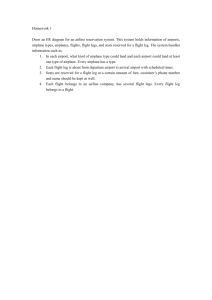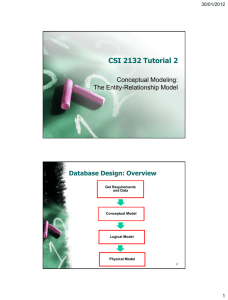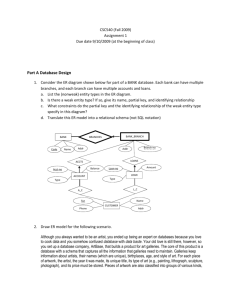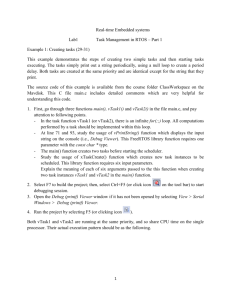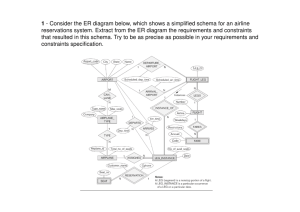Database Design Exercises: ER Diagrams & SQL
advertisement
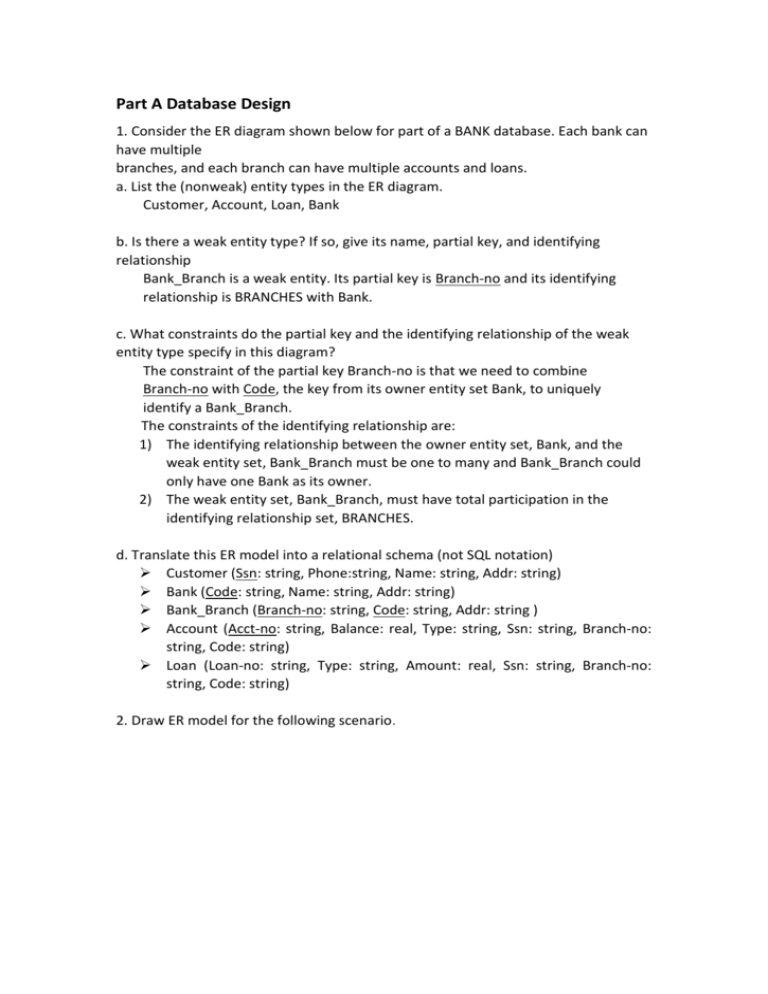
Part A Database Design 1. Consider the ER diagram shown below for part of a BANK database. Each bank can have multiple branches, and each branch can have multiple accounts and loans. a. List the (nonweak) entity types in the ER diagram. Customer, Account, Loan, Bank b. Is there a weak entity type? If so, give its name, partial key, and identifying relationship Bank_Branch is a weak entity. Its partial key is Branch-no and its identifying relationship is BRANCHES with Bank. c. What constraints do the partial key and the identifying relationship of the weak entity type specify in this diagram? The constraint of the partial key Branch-no is that we need to combine Branch-no with Code, the key from its owner entity set Bank, to uniquely identify a Bank_Branch. The constraints of the identifying relationship are: 1) The identifying relationship between the owner entity set, Bank, and the weak entity set, Bank_Branch must be one to many and Bank_Branch could only have one Bank as its owner. 2) The weak entity set, Bank_Branch, must have total participation in the identifying relationship set, BRANCHES. d. Translate this ER model into a relational schema (not SQL notation) Customer (Ssn: string, Phone:string, Name: string, Addr: string) Bank (Code: string, Name: string, Addr: string) Bank_Branch (Branch-no: string, Code: string, Addr: string ) Account (Acct-no: string, Balance: real, Type: string, Ssn: string, Branch-no: string, Code: string) Loan (Loan-no: string, Type: string, Amount: real, Ssn: string, Branch-no: string, Code: string) 2. Draw ER model for the following scenario. ArtistName Age Birthplace CreateDate Title Style Type Name Aritist Create Artwork Price Likes Belong to Name Address Customer Likes Group Name Amount 3. Write SQL statements to create the corresponding relations to the ER diagram you designed for Exercise 2. If your translation cannot capture any constraints in the ER diagram, explain why. Artist: CREATE TABLE Artist(Name CHAR(50), Birthplace CHAR(50), Age INTEGER, Style CHAR(20), PRIMARY KEY(Name) ) Artwork: CREATE TABLE Artwork(Title CHAR(50), Artist_name CHAR(50) NOT NULL, Create_date DATE, Type CHAR(20), Price REAL, PRIMARY KEY(Title) , FOREIGN KEY(Artist_name) REFERENCES Artist ON DELETE NO ACTION) Group: CREATE TABLE Group(Name CHAR(50), PRIMARY KEY(Name)) Artwork_Group: CREATE TABLE Artwork_Group(Title CHAR(50) NOT NULL, Group_name CHAR(50) NOT NULL, PRIMARY KEY(Title, Group_name), FOREIGN KEY(Title) REFERENCES Artwork ON DELETE NO ACTION, FOREIGN KEY(Group_name) REFERENCES Group ON NO ACTION) Customer: CREATE TABLE Customer (Name CHAR(50), Address CHAR(50), Amount REAL, PRIMARY KEY(Name)) Customer_InterestedArtist: CREATE TABLE Customer_InterestedArtist (Customer_name CHAR(50), Aritist_name CHAR(50), PRIMARY KEY(Customer_name, Aritist_name), FOREIGN KEY(Customer_name) REFERENCES Customer ON DELETE NO ACTION, FOREIGN KEY(Aritist_name) REFERENCES Artist ON DELETE NO ACTION) Customer_InterestedGroup: CREATE TABLE Customer_InterestedGroup (Customer_name CHAR(50), Group_name CHAR(50), PRIMARY KEY(Customer_name, Group _name), FOREIGN KEY(Customer_name) REFERENCES Customer ON DELETE NO ACTION, FOREIGN KEY(Group _name) REFERENCES Group ON DELETE NO ACTION) As the relationship between artistwork and group is many to many, we could not put Group_name attribute in artistwork table. Thus, it is impossible to ensure the total participation in the relationship as there is no constraint can guarantee that every group tuple will be in the artistwork_group table. PART B Relational Model and Algebra 4. Consider an update for the AIRLINE database to enter a reservation of a particular flight or flight leg on a given date. a. Give the operations for this update. This involves two operations: 1) An INSERT operation in SEAT_RESERVATION. 2) An UPDATE operation in LEG_INSTANCE to reduce the Number_of_available_seats b. What type of constraints would you expect to check? 1) The INSERT operation needs to make sure the flight number, leg number, seat number, customer name and customer phone are not longer than the length limited. It also needs to check whether the date is valid or not. 2) The INSERT operation needs to make sure the combination of Flight number, leg number, Date and Seat number is unique 3) The INSERT operation needs to make sure flight number could be found in FLIGHT relation, leg number could be found in FLIGHT_LEG relation and date could be found in LEG_INSTANCE relation. 4) The INSERT operation needs to make sure the any of Flight number, leg number, Date and Seat number is not null 5) The UPDATE operation needs to check after the deduction the value of Number_of_available_seats is still not less than 0 c. Which of these constraints are key, entity integrity and referential integrity constraints, and which are not? 1) and 5) is domain constraint. 2) is key constraint. 3) is referential integrity constraint 4) is entity constraint. d. Specify all the referential integrity constraints that hold on the schema shown in the Figure below. 1) FLIGHT_LEG(Flight_number) -> Flight(Flight_number) 2) LEG_INSTANCE(Flight_number) -> Flight(Flight_number), LEG_INSTANCE(Leg_Number) -> FLIGHT_LEG(Leg_Number) 3) FARE(Flight_number) -> Flight(Flight_number) 4) CAN_LAND(Airplane_type_name)-> AIRPLANE_TYPE(Airplane_type_name), CAN_LAND(Airport_code)-> AIRPORT(Airport_code) 5) SEAT_RESERVATION(Flight_number) -> Flight(Flight_number), SEAT_RESERVATION(Leg_number) -> FLIGHT_LEG(Leg_Number), SEAT_RESERVATION(Date) -> LEG_INSTANCE (Date) 5. Consider the LIBRARY relational database schema shown figure below, which is used to keep track of books, and borrowers, and book loans. Write down relational expressions for the following queries: a. How many copies of the book titled The Lost Tribe are owned by the library branch whose name is “Sharpstown”? (temp1, Book_id( Title=’The Lost Tribe’(BOOK) (temp2, Branch_id( No_of_copies )) Branch_name=’Sharpstown’(LIBRARY_BRANCH))) (temp1 BOOK_COPIEStemp2) b. How many copies of the book titled The Lost Tribe are owned by each library branch? (temp1, Book_id( No_of_copies Title=’The Lost Tribe’(BOOK) )) (temp1 BOOK_COPIES) c. Retrieve the names of all borrowers who do not have any books checked out. (temp1, Card_no(BOOK_LOANS) BORROWER) (temp2, BORROWER – temp1) Name (temp2) d. For each book that is loaned out from the Sharpstown branch and whose Due_date is today, retrieve the book title, the borrower’s name, and the borrower’s address. (temp1, Branch_id( (temp2, Branch_name=’Sharpstown’(LIBRARY_BRANCH))) Due_date=TODAY(BOOK_LOANS) temp1) (temp3, temp2 BOOK BORROWER) Title, Name, Address (temp3) e. For each library branch, retrieve the branch name and the total number of books loaned out from that branch (temp1, LIBRARY_BRANCHBOOK_LOANS) Branch_name, count ( Branch_id, count() (temp1)) f. Retrieve the names, addresses, and number of books checked out for all borrowers who have more than five books checked out. (temp1, BORROWERBOOK_LOANS) (temp2, Card_no, Name, Address, count()(temp1)) (temp3, temp2)) count>5( Name, Address,Count (temp3) g. For each book authored (or coauthored) by Stephen King, retrieve the title and the number of copies owned by the library branch whose name is Central. (temp1, ( Branch_id Branch_name=’Central’LIBRARY_BRANCH) (temp2, temp1BOOK_COPIES) (temp3, Title, No_of_copies Author_name =’Stephen King’ BOOK_AUTHORS)) (temp2temp3BOOK) ) 6. Consider the two tables T1 and T2 shown in the figure below. Show the results of the following operations: a. P Q R A B C 10 a 5 10 b 6 10 a 5 10 b 5 25 a 6 25 c 3 b. P 15 15 Q b b R 8 8 A 10 10 B b b C 6 5 P 10 10 25 15 Q a a a b R 5 5 6 8 A 10 10 25 NULL B b b c NULL C 6 5 3 NULL P 15 15 NULL Q b b NULL R 8 8 NULL A 10 10 25 B b b c C 6 5 3 B b C 6 c. d. e. P 10 15 25 10 25 10 Q a b a b c b R 5 8 6 6 3 5 f. P 10 Q a R 5 A 10

